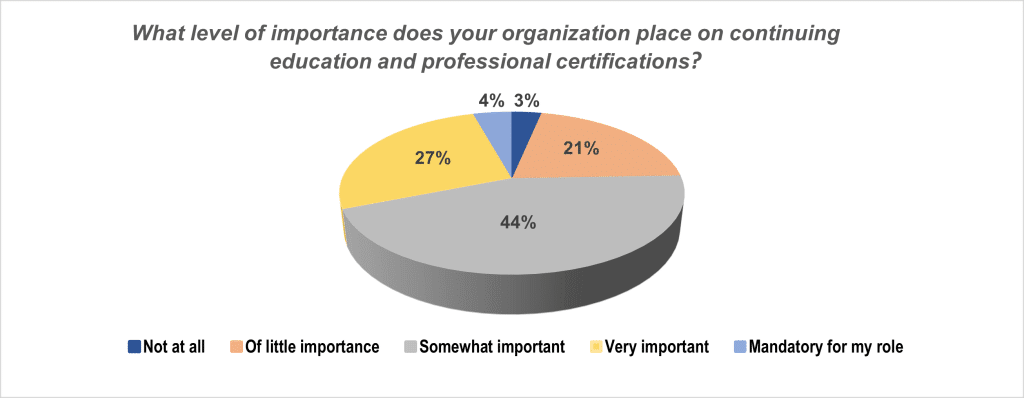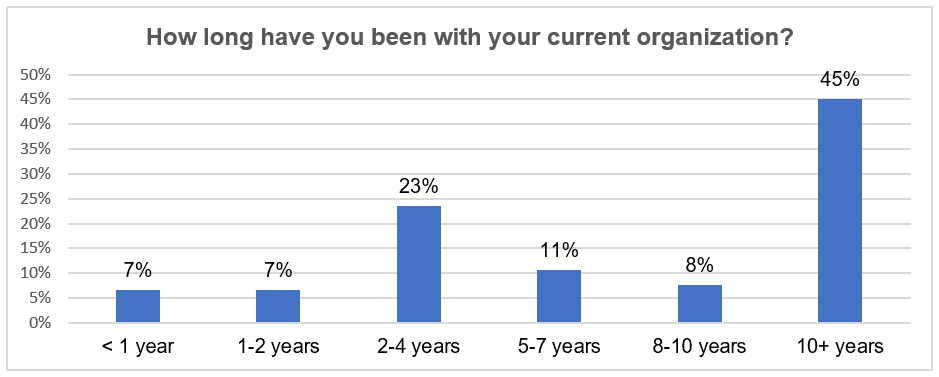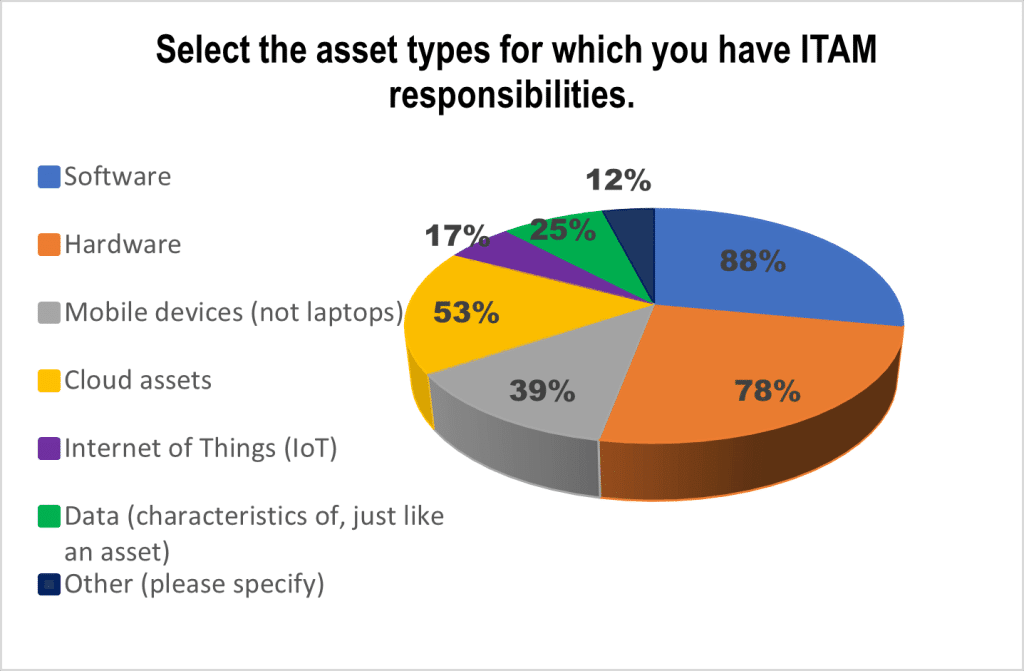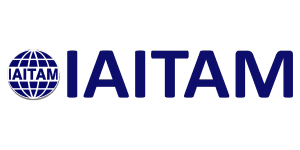The Scope of IT Asset Management: Summary Results of the 2018-2020 Practitioner Surveys
By IAITAM
The practitioner survey for the IT Asset Management (ITAM) profession provides data on how successful the profession, the ITAM program and the individuals in the profession are and, when feasible, with historical comparison. Some of the core questions that capture the goals for the survey are:
- How pervasive across industries are formal ITAM programs?
- Is the ITAM program growing in acceptance and recognition?
- Is the ITAM professional likewise growing in acceptance and recognition?
- How are ITAM programs being staffed?
- What are the characteristics of those in the ITAM profession?
- What is the scope of ITAM-related responsibilities covered by these ITAM professionals?
- What are the salary levels being attained at this time and compared to the past?
The survey results provide insight into the state of the organization and the individuals conducting the ITAM programs within those organizations. The survey explores the characteristics of organizations and the people working in similar capacities across the globe. Owing to the rate of change in the industry and in technology itself, the practitioner survey is not a stagnant document. Regular updates reflect the changes over time.
As a compilation of well-qualified respondents, the survey also provides a view into the perspectives and experiences from those managing and executing the processes necessary for IT Asset Management across the major organizations currently.
Process
Results are received anonymously then correlated and included as percentages of the whole group for that time period. When appropriate, the data is compared to previous survey results data for an ongoing view and analysis over time.
Organizational Characteristics
Insight into what types of organizations have developed IT Asset Management programs can only come from the organization itself. The ITAM program centralizes and systemizes the management of a wide portfolio of IT assets. The value and organization-wide savings and risk management the organizations collection of IT assets is limited due to attempts to manage the assets without cohesion. Reviewing the broad application of ITAM across industries is further validation and evidence for those launching a centralized, systemized ITAM program.
The level of acceptance and support that ITAM is receiving within the organization is revealed through the remarks made about asset management. Reporting structures and staffing indicate a level of commitment, although these results must be considered in relation to the size of the organization.
Encompassing Industries
The people responding to the survey are employed by organizations that span industry classifications. Health care (15%) Banking/finance (10%), Government (10%) and information technology (8%) organizations continue to have a strong percentage of respondents as they have since the profession formalized in 2002. However, healthcare increased steadily over the past 3 years most likely due to continued increases in automation, documentation and formalization of processes involving ITAM.
A Shift in Level
The number of respondents in management level positions (45%) versus those not in management positions (55%) shows negative movement from previous years (49% & 51%). Further study would be needed to determine the root cause of this shift. Of further interest is, previously (2017) a majority (67.5%) of the respondents reported as a director or higher (including CEO) although there are also quite a few respondents that checked the “other” category implying that the titles of their management did not fit into the categories provided. In the past three years this has dropped to 45% of those responding, a statistically significant change.
There is also a significant decrease in the number of direct reports to ITAM managers ranging from 5%-16%. Having obtained only the numbers, further analysis is needed to define and assess the causes and direct impact on AM processes with seemingly fewer staff.
Note that there is no clarification of full-time or part-time reflected in these percentages.
Is ITAM Incorporated into Organizational Infrastructure and To What Level?
ITAM staffing (along with others) remains variable due to a variety of organizational factors, however, the recognition of ITAM in the job description continues to be a significant indicator of formal recognition for the ITAM role. The most recent survey indicates that only 68% of those responding have a current job description and 46% stated it only covers between 75-100% of their responsibilities. Which shows that 54% do not or only in a limited manner, adequately describe the ITAM role. This continues to be an area of concern and need for education and ongoing encouragement. Further, answers to the question: “How many in your organization have ITAM responsibilities in their job descriptions?”, show no statistical evidence of overall change in the past 4 years, with only 1-10 people having 80% of the ITAM responsibilities in their Job Description
Budget
The existence of a separate ITAM budget offers additional infrastructure criterion of recognition of value delivered and a view into the costs of an ITAM program. The additional recognition of the program with a separate budget is a better indicator of visibility to executive management. In the 2014 survey, almost half of the respondents had a separate budget. In 2017, the percentage of organizations with separate budgets for ITAM dropped slightly from the 2014 high to 44.6%. The most recent compilation of responses shows this has increased to 51% of specifically designated ITAM programs with a defined budget. This is an encouraging recognition of the need and attention that ITAM is requiring.
However, with 41% answering that the budget is not separate, continued assessment of the placement of ITAM responsibilities within the organizational structure is an excellent topic to consider for further study. In the past, diversity in organizational positioning was expected except for at least a minimum core set of responsibilities within an IT group. This may still be the case for ITAM and is worthy of a future survey.
eates information and process gaps for hardware. Making matters worse are all the end-user assets now in remote work locations.
Acknowledging the need for a more robust system, ITAM has been re-established as the worldwide standard. In 2019, Axelos rolled out ITIL 4, the first update of global best practices for delivering IT services since 2011. After making ITAM optional in the previous guidelines, ITIL 4 reintroduced the need for ITAM as a core function.
Cloud software that supports tracking of both on-premise and remote assets in use by work-at-home employees can help companies effectively manage availability, security, compliance and costs.

Owing that 8% of the responses answered “Unknown” may indicate a need for ongoing education on department processes and a better understanding of the impact of budget to outcomes.
In a second question to be answered only by those with a separate budget, 45% answered that the budget was the same or less than the previous year. Almost 23% saw an increase of 1-20% in the most recent surveys.
Formalizing ITAM Positions
Individuals with job titles specific to ITAM or a Key Process Area within ITAM and their time in that role is moving into a ‘Bell Curve’ distribution with the less than 2 years at 17% and the 2-7 years at 57% and the 8+ years at 26%. The ITAM profession has now established itself in the Human Resources title-salary lists, confirmed by the length of time that the respondents have been in their positions.
As ITAM becomes more formalized within the organization’s structure, a requirement for certification is increasing over the past 6 years. When asked if certification was a requirement, only 24.1% answered yes, but that is a steady increase over time since only 14% required certification in 2014 and 22.3% in 2016 and most recently this has increased to 29%. While it may not be a requirement for all, as noted in this graph, 76% of the respondents reported that their organizations take continuing education and professional certification seriously
Significantly the question; Do you feel that IT Asset Management is valued by your peers and senior management? Had an 82% response of ‘Somewhat to Utmost value”. Organizations are becoming more and more aware of the risks, benefits, and ROI of ITAM.
Staffing Commitment
It is very encouraging to see 72% of the organizations responding have IT Asset Management staff who are all employees. There has also been a decrease in the number of organizations that have employees with a few temporary staff. Further, there has been a significant decrease in organizations that outsource or use Temps for their ITAM program to only 9% of the respondents.
This enhanced level of dedication to ITAM is significant. As noted previously, a job description with ITAM defined in it, is an empty commitment if there is no time or dedicated resources given to execute those tasks. When addressing the question “of the people in your organization recognized as members of the ITAM program most:” the answers were:
- dedicated full-time to the program (they are solely focused on ITAM) – 58%
- Have other duties and are dedicated part-time to the program (they spend approximately half their time on ITAM) – 26%
- Only dedicate a small portion (less than ½) of their time weekly/monthly to the ITAM program – 16%
ITAM processes only being worked on half the time the employees are working is challenging for an environment in which must do more than survive events, such as a refresh or an audit. However, it should be noted that these results are improving over previous years data.
ITAM Value
Respondents are asked how they feel IT Asset Management is valued by their peers and the executives of the organization. This offers a subjective view on the degree of acceptance that ITAM receives. The value perceived by others is an indicator for how much support ITAM receives from funding to participation. The overall trend of perceived value (when all the answers from “somewhat” to “utmost” value are totaled) is over 81%. To evaluate some aspect of measurable value, respondents were asked about percentage of savings reported in the previous year.
As relates to hard dollar value of a well-executed ITAM program 88% of our respondents indicated cost savings from 1% to 15%. A smaller number of programs received more validating that each was able to identify significant savings and ROI through active ITAM.
Who are these Professionals?
To evaluate the responses best, information about the individuals answering the questions is helpful. These answers can also provide data about career trends for ITAM.
Personal Information
From the first surveys, the respondents have come from all age groups but have followed the consistent pattern of an increase in ITAM professionals in the categories over 35 years of age. Recent responses show 91% of ITAM professionals are over the age of 36. This means only 9% of our industry is between 18 – 35 years of age. There is research to be done on why, and marketing strategies to create, to ensure an educated and sufficient supply of men and women are available to fulfill the ongoing needs and requirements of organizations.
As surveys have shown in the past, the education level of ITAM respondents remains dominated by those with some college education or with a college degree. However, advanced education beyond college is growing over time, albeit slowly.
For some insight into career trajectories, a survey question asked what department the respondents worked in prior to ITAM. IAITAM’s recent surveys show that 62% of the respondents previously worked in some capacity as part of the IT department including IT Helpdesk/Support Services (19%). A sizeable minority, 12%, came from procurement or finance. A notable increase in those who began their first job in ITAM has risen to 3%, vs 1 – 2% in previous surveys.
A clear recognition of the value of having an ITAM certification is shown in the increasing number of ITAM professionals who have been certified in each level. Each of these certifications have increased by several percentage points in the past 3 years.
Question: What ITAM certifications do you hold? Select all that apply.

Length of Service
During the past few years of ‘Job Hopping’ and ‘Employment at Desire’, ITAM professionals appear to be part of the norm, until they reach the 2 to 4-year mark. Then, it appears they settle in by the 10-year mark. This is supported in general according to a new study from IBM’s Institute for Business Value.
Workers have been job hopping in the hopes of attaining better pay and career mobility in the uncertain Covid-19 economy, and it is a trend that millennials and Gen Z are expected to dominate again in 2021.One in four workers plan to switch jobs this year, an increased pace compared to last year. Of the one in five workers who switched jobs last year, 33% identified as Gen Z and 25% as millennial. https://www.ibm.com/thought-leadership/institute-business-value/report/employee-expectations-2021

Roles Performed
The specific ITAM roles held by an individual can be anything from a single process role to a unique combination of roles. Some decisions are based on organizational strengths, weaknesses, and politics. Other choices are dictated by the size of the organization as well as having a global scope since the number of offices, countries, and divisions impact ITAM. The decision for staffing the roles is also influenced by the maturity of the ITAM program and how broadly the assets and processes are in the hands of the ITAM professionals. With this complexity, standards for staffing and structure are organizationally specific rather than a best practice.

To gain some understanding of the variation in roles and responsibilities, respondents were asked to check yes if they held any role that is part of the processes for Software Asset Management, Hardware Asset Management or Mobile Asset Management. This is the compilation of the past 3 years.
Another way to describe the roles in which the respondents are involved is to track those critical documents during the life of the asset as commonly understood touchpoints. Such a list requires regular updating to remain relevant and address new requirements. These results offer insight into the details of what is being done at a practical level.
Question: Select all the documents and activities from the list below that are part of your responsibilities:

Salary
Each year, respondents provide their salaries. This permits anonymity for reporting and the aggregate values provide insight for ITAM professionals on the range of remuneration currently offered. IAITAM has included the question for several years, and interestingly, the distribution percentages have remained essentially the same since 2012. The graph shows the most recent compilation of responses, and it shows no statistical variation from the previous levels with the exception of an increase of 1% in the top two salary levels over the previous surveys.

Conclusion
This survey content offers a true source of relevant information that can be used for annual planning, strategic planning, or a career in ITAM. The IT Asset Management profession is based on a strategic roadmap, but one that must be flexible to reflect changes in direction based on technology, industry changes and the economy. Due to the ‘world-wide upheaval’ the past 18 months the number of returned surveys (n) incorporated for this report is less than in previous submissions. However, it is notable that the data percentages did not change from a statistical relevance level. The numbers still are remarkably similar to previous years of data.
The survey results indicate an ongoing growth in acceptance and understanding of the critical nature of ITAM to every organization. During the recent difficult economic times, the profession and the ITAM program have grown in importance and perceived value. From the documents that the respondents work with, the goals that they identify and the salaries that they earn. The importance of an accurate inventory throughout the lifecycle remains a priority for organizations. ITAM is integral to other frameworks such as IT service management as well as contributing to the procurement, financial management and security of an entire portfolio of technology assets.
It is hoped that the results of this survey will encourage ITAM professionals to expand their vision for ITAM beyond current limitations, moving the program forward in response to the organization’s goals and perhaps to be influenced by the goals that others have identified. Certainly, the success represented here (as well as shared woes) provides external feedback for those immersed in delivering IT Asset Management processes.
